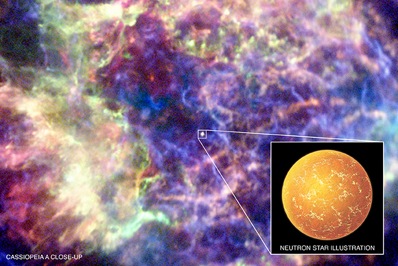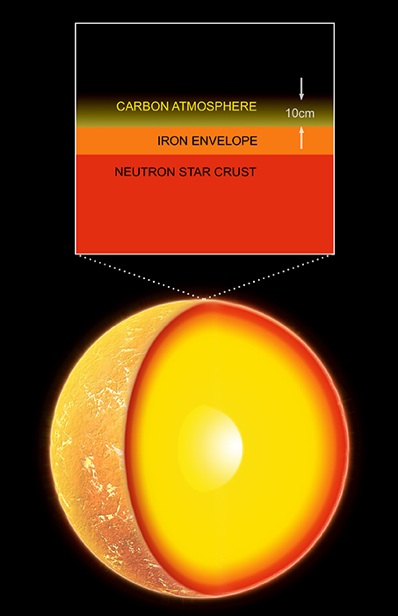
Carbon atmosphere discovered on neutron star
DR EMILY BALDWIN
ASTRONOMY NOW
Posted: November 05, 2009


The ten year mystery of supernova remnant Cassiopeia A's central compact X-ray source can be explained by a hot neutron star with a low magnetic field and a carbon atmosphere, say scientists Wynn Ho and Craig Heinke.
Cas A is just 330 years old, making it one of the youngest in our Galaxy, and a key player in constraining theories of the evolution of stars.
 The point-like source at the centre of Cas A has been known to astronomers for over a decade but new research suggests this neutron star is coated with a thin carbon atmosphere. Image: X-ray: NASA/CXC/Southampton/W. Ho et al.; Illustration: NASA/CXC/M. Weiss. The point-like source at the centre of Cas A has been known to astronomers for over a decade but new research suggests this neutron star is coated with a thin carbon atmosphere. Image: X-ray: NASA/CXC/Southampton/W. Ho et al.; Illustration: NASA/CXC/M. Weiss.
“The compact star at the centre of this famous supernova remnant has been an enigma since its discovery,” says Wynn Ho of the University of Southampton. “Now we finally understand that it can be produced by a hot neutron star with a carbon atmosphere.”
NASA's Chandra X-ray Observatory took spectra of the neutron star, finding it coated with a thin veneer of carbon, the first time the composition of an atmosphere of an isolated neutron star has been confirmed.
Chandra's "First Light" image of Cas A in 1999 revealed a previously undetected point-like source of X-rays at the centre. The object was assumed to be a neutron star, but it did not show any X-ray or radio pulsations or any signs of radio pulsar activity. Models suggest that if a carbon atmosphere was present, however, the X-ray emitting region would uniformly cover the star and shine equally in all directions, thus no changes in intensity would be noted as it rotates.
 The carbon atmosphere on Cas A's central neutron star is just ten centimetres thick with a density similar to diamond and a pressure more than ten times that found at the centre of the Earth. Image: NASA/CXC/M. Weiss. The carbon atmosphere on Cas A's central neutron star is just ten centimetres thick with a density similar to diamond and a pressure more than ten times that found at the centre of the Earth. Image: NASA/CXC/M. Weiss.
Previous models for the object's X-ray emission spectrum implied either a stellar radius too small for a neutron star, a neutron star with a hydrogen atmosphere, or one with a hot spot that produces X-ray pulsations as it rotates.
“Our carbon veil solves one of the big questions about the neutron star in Cas A,” says Craig Heinke of the University of Alberta. “People have been willing to consider some weird explanations, so it’s a relief to discover a less peculiar solution.”
Neutron stars are extremely dense objects, typically with diameters of around 20 kilometres. The thin carbon atmosphere is a miniscule 10 centimetres, compressed by a surface gravity that is 100 billion times stronger than on Earth.
“For people who are used to hearing about immense sizes of things in space, it might be a surprise that we can study something so small,” says Ho. “It’s also funny to think that such a thin veil over this star played a key role in frustrating researchers.”
The carbon originates from material that has fallen back on the stellar core after the supernova event, and nuclear reactions on its hot surface which convert hydrogen and helium into carbon. The X-ray spectrum and lack of pulsar activity suggests that the magnetic field on the surface of the star is relatively weak, but how this may evolve in the future is, as yet, unknown.
Given its youth of just a few hundred years old compared with other well-studied neutron stars bearing ages of several thousand years, Cas A serves as a valuable window into the early life of a cooling neutron star.
The results of this study are reported in the latest edition of the journal Nature.
|



